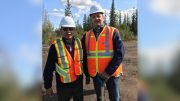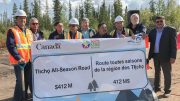Since moving to Whatì, Byrne Richards says internet availability has made it difficult for him to do his job.
“This world that we’re living in today has a significant requirement for face-to-face or screen-to-screen connection,” he explains. “It is increasingly difficult to do that, with the bandwidth that we have.”
Whatì Chief Alfonz Nitsiza says connectivity has been a regular issue in the community, but the territorial and Tłı̨chǫ government say a possible solution is in the works.
With the Tłı̨chǫ Highway being built, the two governments are hoping to “piggyback” on the project and establish a fibre optic cable to the rural community.
However, no timeline has been provided and in the meantime Richards says he will just have to “be selective” with his internet usage.
‘An issue since day one’
When Richards first moved to Whatì seven months ago, he said it took six weeks for his internet to even be set up.
He was forced to use his phone to stay connected in the midst of a global pandemic.
“So I had to increase my [data] package on my phone to unlimited,” he explains.
Nitsiza says connectivity has always been a problem.
“You know it’s not reliable, really,” he says of the internet, “it’s been an issue since day one.”
The subject of unreliable internet was brought up in the Legislative Assembly on Oct. 22, when Jackson Lafferty, the MLA for Monfwi, questioned why the Tłı̨chǫ region wasn’t prioritized for receiving better internet connection. He referenced the $82 million spent on the Mackenzie Valley fibre optic line.
“Why can’t we find an extra little bit that would help households, schools, and nursing stations and businesses to now enjoy the benefits of this line that their very own tax dollars built, for my riding in Monfwi?” he asked in the assembly.
Caroline Wawzonek, minister of Industry, Tourism and Investment, responded by saying the Tłı̨chǫ government and GNWT are working on the project to create a fibre optic line to Whatì.
“This is going to be a project that would be led by the Tłı̨chǫ government, but the GNWT is going to partner and provide support as well as some financial supports in terms of preparing their project,” she told the assembly.
CKLB spoke with Wawzonek about the project, which she said is still in its early stages.
“The idea behind this comes from the fact that there’s a road to Whatì being built right now. And so looking at whether or not that creates an opportunity to piggyback on the road construction to to put a fiber line in,” she explains.
A federal commitment
In a press release, the federal government promised to provide all Canadians high-speed internet by 2030.
The release said $150 million is being set aside for the Rapid Response Stream for the Universal Broadband Fund, available to projects that will be completed by November 15, 2021.
Wawzonek says this commitment by the federal government will allow for the GNWT to start making progress.
“The federal government has also recognized the need, and as a result of which you get the universal broadband funds being advanced, and hopefully being expanded,” she says.
Nitsiza says officials are also talking with the federal government about additional funding for the project.
The Tłı̨chǫ government is also holding discussions on the project with Kiewit, the construction company working on the Tłı̨chǫ Highway, he adds.
“I’m told that things are happening, so that’s good news,” Nitsiza concludes.









